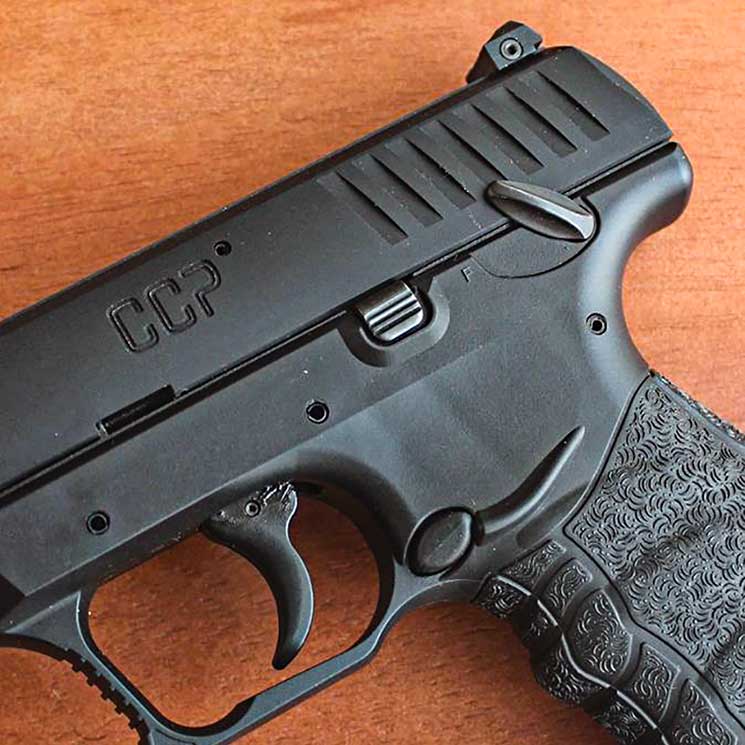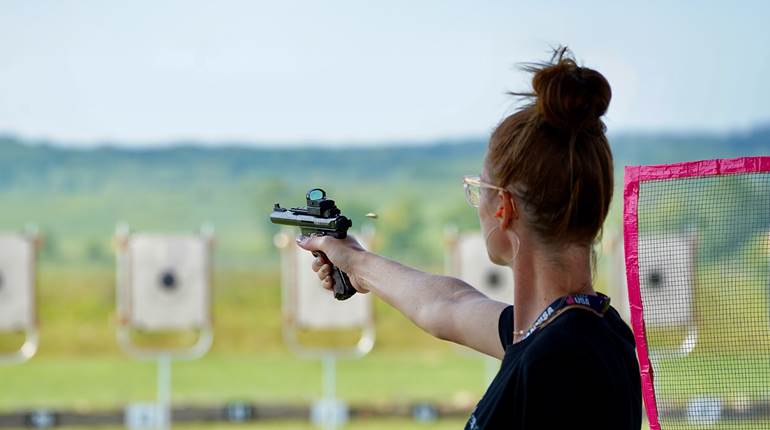
There was a time when a certain unwritten rule about concealed carry handguns was often promoted around the shooting ranges. It goes something like this, "If the recoil from the gun doesn't hurt a little when you pull the trigger, then the gun isn't suitable for self defense. Don't worry, just keep shooting until you get used to it."
This 'learn-to-love-it' defensive pistol philosophy made sense during WWII when American G.I.s of all shapes and sizes were issued Government Model 1911 semi-automatic handguns chambered in .45 ACP. It didn't matter if the grip fit their hands or if the recoil was manageable—that was their gun, and they'd better learn to run it!

Today's civilian handgun market is a different story. We are enjoying a golden age of product diversity with more options to choose from than ever before. Some companies, including Walther Arms, are striving to tame felt recoil for those who prefer or need softer-shooting carry pistols, including small-frame individuals, seasoned citizens and those who want longer practice sessions for improved accuracy and greater confidence.

In 2014, Walther introduced the CCP 9 mm semi-automatic pistol, which employs a gas-delayed blowback action design called the Softcoil system. In 2018 the company released the CCP M2, which eliminated the need for a special disassembly tool for routine cleaning. For 2020, the company is now shipping the latest edition to the line-up: the CCP M2 chambered in .380 ACP.

In regards to external dimensions, features and appearance, the .380 ACP version of the CCP M2 is the same as the 9 mm version. This means the latest edition to the M2 lineup is compatible with existing sight upgrades and carry systems like the DeSantis Inner Piece 2.0 IWB holster.

However, the .380 ACP model is slightly lighter, because the slide is CNC-machined from 7075 aluminum with steel supports at key points. The 9 mm slide is constructed from solid steel. The .380 ACP slide can function safely with less mass, since this cartridge operates at the much lower maximum pressure level of 21,500 PSI compared to the 9 mm's pressure levels, which can go up to 35,000 PSI. The lighter slide gives the .380 ACP version a nice sense of balance without feeling nose-heavy like some polymer-frame pistols.

The reduced-weight slide is supported by a lighter recoil spring, making it easy to manually cycle. This is possible thanks to the gas-delayed action configuration. Traditional blowback-operated pistols rely on slide mass and stiff recoil springs to keep the action closed when the gun is fired. The CCP M2 has a hinged piston attached to the front end of the slide that rests inside a gas cylinder located in the frame below the fixed barrel.

When the pistol is fired, a portion of the gas produced by the cartridge is used to pressurize the cylinder. This pressure delays the rearward movement of the slide until the bullet leaves the barrel and the pressure drops. The slide then moves rearwards to eject the spent cartridge case and is then pressed forward again by the recoil spring to chamber a fresh round. The result is a pistol with a modest level of felt recoil, despite the light slide and recoil spring.

The beveled slide is available in a black (shown) or silver finish with front and rear slide serrations. The polymer, 3-dot sight system consists of a fixed front sight with rear sight that's click-adjustable for windage. Sight-picture height can be adjusted by trading out one of the three front sights included with the pistol. The 3.54" barrel features polygonal rifling and a witness hole in the top of the chamber.

The double-action only trigger has a 0.27" arc of travel with a consistent, smooth feel for a striker-fired platform. Although the trigger pull is listed at 7 lbs., this pistol's trigger weighed in at 5 lbs. 8 oz. at the end of the range test. The external controls, including the slide lock, frame-mounted thumb safety and polymer button magazine release, are located on the left side of the black polymer frame. The slide lock is small, but it can be manually manipulated with a modicum of effort. The thumb safety swings up into the Safe position and down to Fire, clicking distinctly into these positions. The magazine release button is reversible for left-handed operation.

The frame's dust cover features a molded in 1.25" long 3-slot M1913 Picatinny accessory rail for lights and lasers. The trigger guard is undercut where it meets the grip, and its face is flat and grooved to act as a finger rest. The grip features Walther's Hi-Grip Surface Texturing on all four sides with finger grooves along the front, swells on the sides and a deeply curved backstrap. I have somewhat smaller hands, so this grip configuration felt like it was custom-built just for me. Folks with larger hands may not find it to be as comfortable as I do.

The pistol ships with two 8-round CCP magazines, which have been modified with an internal spacer to compensate for the shorter .380 ACP cartridge. This pistol does have a magazine disconnect safety, which disengages the trigger to prevent the pistol from firing when the magazine is removed. A bronze cleaning brush for the piston cylinder is also provided.

The procedure for field-stripping the CCP M2 is simple, but it's different from other striker-fired pistols. Start by removing the magazine and verifying the pistol is empty of any ammunition. Keep an empty magazine handy, because you'll need it. With the slide in the closed position, insert an empty magazine into the grip. With the pistol pointed in a safe direction, pull the trigger. The red cocked striker indicator will move forward into the slide, leaving the locking block port empty.

I found it was helpful to apply a little pressure to the locking block while sliding the locking block release to the right. The locking block will move rewards out of the slide assembly, exposing the striker spring. Lift the striker spring away from the locking block and remove the magazine from the grip. Press the slide backwards about a quarter of an inch, and then lift the rear of the slide up and away from the frame. Move the slide forward off of the barrel, and then remove the recoil spring from the barrel.

Depress the firing pin safety (inside the slide) to remove the striker assembly from the slide. The pistol is now ready to clean. Reassembling the pistol is fairly straight forward as well. Don't forget that the hinged gas piston on the front of the slide needs to be aligned with the gas cylinder under the barrel when the slide is set back on top of the frame. It takes a little patience on the first couple of tries, but it’s simple to do once you've got the hang of it.

At the range, the CCP M2 .380 ACP proved to be soft-shooting and reliable with a variety of loads, including full-metal jacket ammunition and defensive hollow points. There was a single stovepipe within the first 20-rounds of practice-grade ammunition fired but no malfunctions, mechanical or ammunition related, after that. Formal accuracy testing was conducted at 15-yards for five 5-shot groups, and bullet velocity was measured by firing 10-shot strings next to a Labradar chronograph with a 12" offset from the muzzle.

The .380 ACP defensive loads tested here included Barnes, Browning and Hornady hollow point offerings. Accuracy was slightly better the 9 mm version of the CCP M2 the American Rifleman staff tested recently with group sizes hovering around 2.5” in size.

At the end of the day, I'm going to stick to the admonition that self-defense practitioners should carry as much pistol as they can safely manage and practice with regularly. If you can handle a .45 ACP, .40 S&W or 9 mm, then Walther's got you covered with other models from the company's CCP, PPS and PPQ product lines.

However, if you're in the market for a low-recoil defensive option, the kick of the new CCP M2 .380 ACP neatly splits the difference between the modest recoil of the 9 mm CCP M2 and the mild recoil of the similarly sized and shaped Walther P22 rimfire pistol chambered in .22 LR. With its easy rack slide, this .380 is a highly accessible defensive pistol suitable for a wide range of hand strength levels. The sights are useful, the trigger is smooth and the soft recoil makes it all-day comfortable to practice with. Suggested retail prices for this version of the CCP range from $469 to $489, but real-world prices are much closer to $400, making it affordable as well as pleasant to shoot.

---------------------- Walther Arms CCP M2 .380 ACP Specifications: ----------------------
Manufacturer: Walther Arms
Model: CCP M2 .380 (5082500)
Action: Gas-Delayed, Blow-Back Operated, Semi-Auto Centerfire Pistol
Caliber: .380 ACP
Slide: CNC Machined 7075 Aluminum with Steel Supports
Slide Finish: Hard Coat Anodized, Matte Black or Silver
Slide Serrations: Front and Rear
Frame: Finger Grooved Black Polymer with Hi-Grip Surface Texturing
Accessory Rail: 1.25" 3-slot M1913 Picatinny
Sights: Polymer 3-Dot, Drift Adjustable Rear, Interchangeable Front
Slide Lock: Low Profile
Magazine Release: Polymer Button, Reversible
Trigger: Double-Action Only
Trigger Pull: 7 lbs. (Listed), 5 lbs. 8 oz. (As Tested)
Barrel Length: 3.54"
Overall Length: 6.41"
Height: 5.12"
Slide Width: 1"
Grip Width: 1.18"
Weight: 21.4 oz. with Empty 8-Round Magazine
Capacity: 8+1
Rifling: Polygonal
Accessories: Foam Lined Hard Case, 2 Magazines, 2 Additional Front Sights, Bronze Piston Channel Brush, Owner's Manual, Lock
MSRP: $469 - $489
DeSantis Gunhide Inner Piece 2.0 with 360 Holster C-Clip $39.99






































